A home fruit garden care calendar is an invaluable tool for gardeners, offering structured guidance to ensure optimal growth and productivity throughout the year. This calendar provides a month-by-month outline of essential tasks such as planting, watering, pruning, fertilizing, and pest control, tailored to the specific needs of various fruit-bearing plants. By helping gardeners stay organized and proactive, it prevents overlooked tasks and ensures that plants receive the right care at the right time. This leads to healthier plants, more bountiful harvests, and the satisfaction of nurturing a thriving, fruitful garden. Whether you’re tending to citrus trees, berry bushes, or stone fruits, a care calendar is a reliable reference that simplifies planning and fosters successful, year-round cultivation.
Here’s our season-by-season fruit garden care tips:
Spring checklist for fruit growers
- Spring is the time for planting fruit trees, bushes, brambles, and other soft fruits. The best location for fruit is a place in full sun, with deep, well-drained, humus-rich soil. Grow fruits away from frequent breezes or winds and away from low spots where cold air and frost can settle.
- Bare-root and balled-and-burlapped fruits will be available in early spring. Begin planting as soon as the soil thaws and begins to dry out.
- Winter-pruning of fruit trees—removing winter-damage growth–should be completed in early spring and brambles should be thinned. The final dormant spray applications should be completed before the buds begin to swell. Tree wraps and other protection can be removed as the days grow longer.
Fruit Tree Care Products from Amazon:
- When heavy frost has passed, remove mulches from established plants. Fertilize or top-dress with compost around established plants and replace mulches once the soil has warmed.
- Spring is the time to watch for pests and signs of disease. Pest insect larvae should be trapped and destroyed in spring.
- As soon as the inclement weather subsides most frost protection can be removed. Be sure to do this as pollinating insects begin visiting plants. Replace frost protection with netting to protect developing fruits from birds.
Early summer checklist for fruit growers
- Most soft fruits–strawberries, raspberries, blackberries, blueberries, and currants–are bearing or nearing maturity by early summer.
- Tree fruits–apples, pears, plums, peaches, and nectarines–in early summer are developing fruit. Attention should be given to thinning, pruning, and watering.
- Support heavily laden branches with stout stakes that are deeply forked at the top.
- Trees being grown in restricted form–as espaliers, cordons, or headed back–need summer pruning. This will keep the plant to size and encourage new growth. Prune trees to open up the centers. Prune bushes to make spraying and picking easier. Pruning will let light and air into the leafy center of the plant so that the color of the fruit is improved.
Mid-summer checklist for fruit growers
- Fruits are ripening by mid-summer. Keep fruit trees and vines thoroughly watered; avoid letting plants dry out, especially newly planted fruits and fruits growing in containers.
- Scavenging birds and insects will be looking for an opening as fruits ripen. Use bird netting or reflective tape to scare birds away; spray away insects with a strong stream of water; use copper or sulfur sprays when diseases appear.
- Full-grown fruit trees need to be watered deeply once or twice a month; in very hot regions irrigate fruit trees deeply two or three times a month. Trees in sandy soil need more water as do young trees that are not yet established. Fruit trees are especially thirsty the last two weeks before harvest.
- New whippy growth needs to be trained into place through the course of the season–while the growth is still soft and pliable. Tie new growth into wires or trellises firmly, but gently. Wires or training poles can be removed in a season or two when the wood has hardened. Summer prune established espaliers and cordons, cutting back new laterals and side shoots.
- Prune away dead, damaged, and diseased wood from fruit trees first; thin out overcrowded growth to allow the sun and air into the center of the tree. Apples, apricots, and pears bear on spurs. Cut the new growth back to two or three buds; this will stimulate fruit production. When old wood no longer bears, you will replace it with fresh growth; old wood can be cut out during winter dormancy. More at: Pruning Fruit Trees
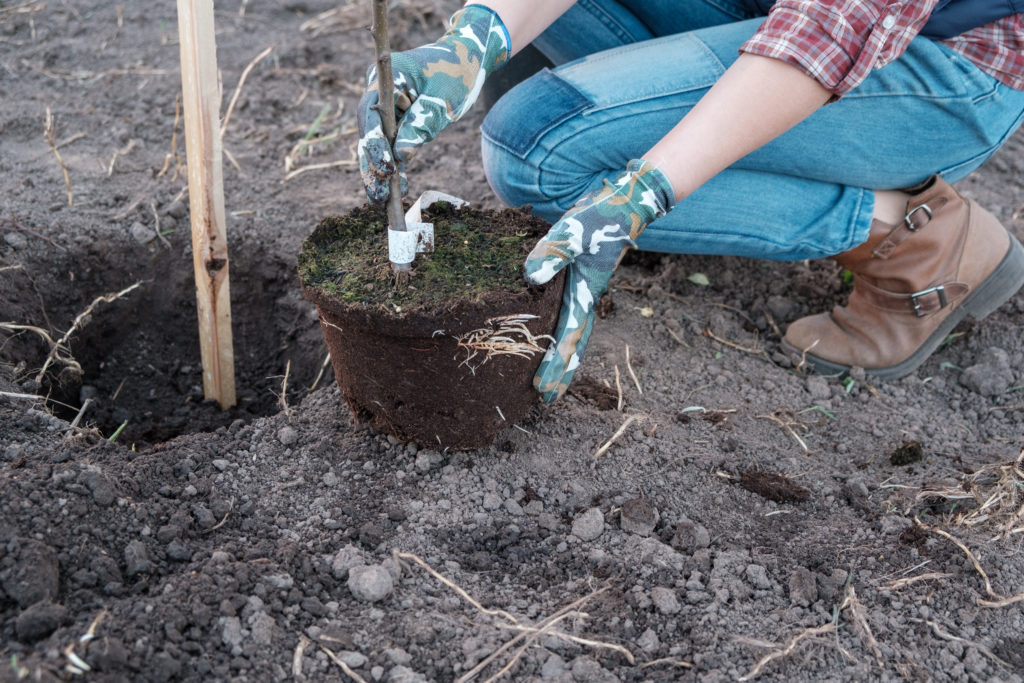
Fruit Trees Crop-by-Crop Tips
Click on any of the following crops to see complete growing and harvesting information and tips.
Apple
- Early spring: Begin planting bare roots as soil and weather allow.
- Mid-spring: Most varieties flower now or in late spring. Protect blossoms from frost. Coddling moths will begin mating; hang pheromone traps to attract and catch males. Inspect dwarf trees and hand-pick caterpillars.
- Late spring: If pollination is successful, fruitlets form now and begin to swell. Water newly planted trees if the weather is dry. Check for powdery mildew and scab on fruitlets. Hang apple maggot traps in trees now or in early summer depending on when the adult flies emerge.
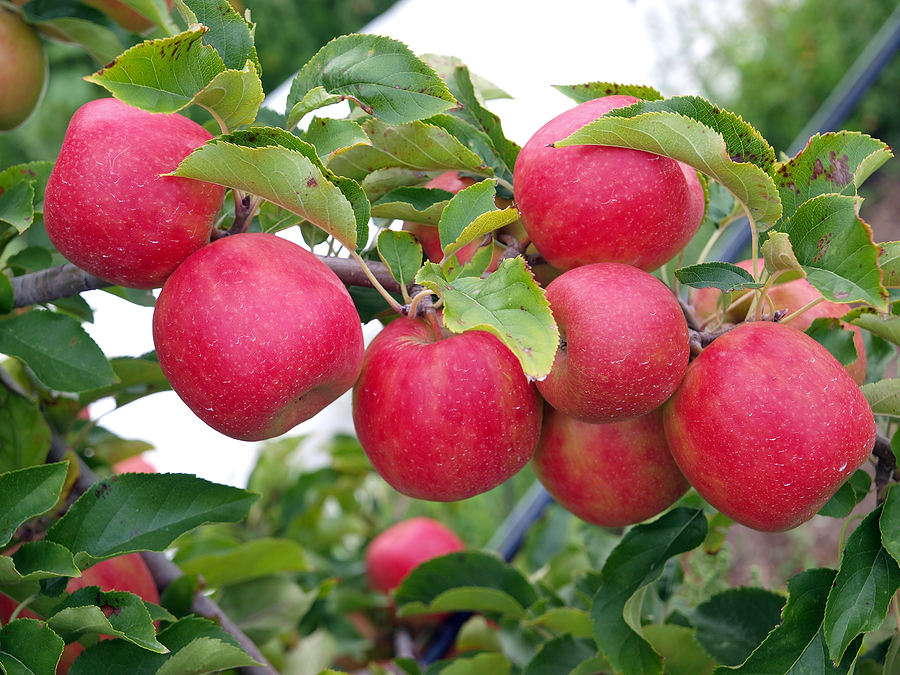
- Early summer: Support heavy cropping trees with a stake for each branch or by ties from a center post. Complete fruit thinning as soon as the natural drop is over. (Natural or June drop happens in early summer when acorn-sized fruitlets fall to the ground; the tree’s way to ensure that it is not overloaded with fruit.) Hand thin the number of fruits to one in every flower cluster with a final spacing of 4 to 6 inches (10-15 cm) for dessert fruits. Larger fruit and cooking varieties should be spaced more widely, 6 to 9 inches (15-23 cm) apart. Look for codling moth damage–tunneling; remove and destroy damaged fruit. Paper or nylon bags in place to protect fruit should be securely banded. Larvae can be trapped in sticky bands and destroyed. Watch for red spider mites that live and lay eggs on the undersides of leaves. Release predatory mites as a biological control or spray with soapy water or neem oil. Wooly aphis which appears as a white wooly covering on the undersides of leaves can become thick as the season proceeds. Aphis will cause leaves to curl and distort. Ladybugs and lacewings are natural predators. Apple and pear scab–brown, scabby fungal growths caused by humid conditions–can leave fruits small, distorted, cracked, and rotting. Remove and dispose of infected fruit. Apply a fungicide, and prune for increased air circulation next winter. (Scab also attacks nectarines, peaches, and plums.) Check for pear psylla; infested leaves will be yellowed from insects that suck on plant juices. Spray with insecticidal soap. Keep weeds or grass under trees cut back. Summer prune cordon, espalier, and dwarf pyramid trees. Prune pear trees first and later apple trees as harvest is completed for the next month or two. Some summer pruning is essential to control trained trees. As new shoot wood hardens–test by bending them between your thumb and forefinger, cut back to about five leaves. Do not prune back leaders of branches selected to extend the tree’s framework until the tree has filled its allotted space. Check to make sure wire or plastic ties on trained trees are not cutting into stems and branches.
- Mid-summer: Pick early-maturing varieties while slightly under-ripe; these will retain the best flavor once off the tree. The fruit is near-ripe when you gently lift and twist and the fruit parts easily from the spur. Protect ripening fruit again birds and wasps; use nets or cloth or paper bags over fruits. Pick diseased and damaged fruit (look out for pears infected with scab or brown rot) out of trees and pick up fruit drops in the garden; do not allow spoiled fruit to attract pests.
- See also How to Choose an Apple Tree for Planting and Apple Pruning and Thinning Apples.
Pear
- Late winter: Spray trees with dormant oil to protect against aphids, pear psylla, and other pests. Prune trees before the dormant period ends.
- Early spring: Begin planting bare-root trees.
- Mid-spring: Most varieties flower now. Protect blossoms from frost. Hang pheromone traps to catch male coddling moths before they mate. Inspect dwarf trees and hand-pick any pest caterpillars.
- Late spring: Water newly planted trees if the weather is dry. Check for powdery mildew and signs of scab.
- Early summer: See tasks under Apple above.
- Mid-summer: See tasks under Apple above.
- See also, How to Choose a Pear Tree for Planting and Pear Pruning and Pear Varieties for Backyard Gardens.
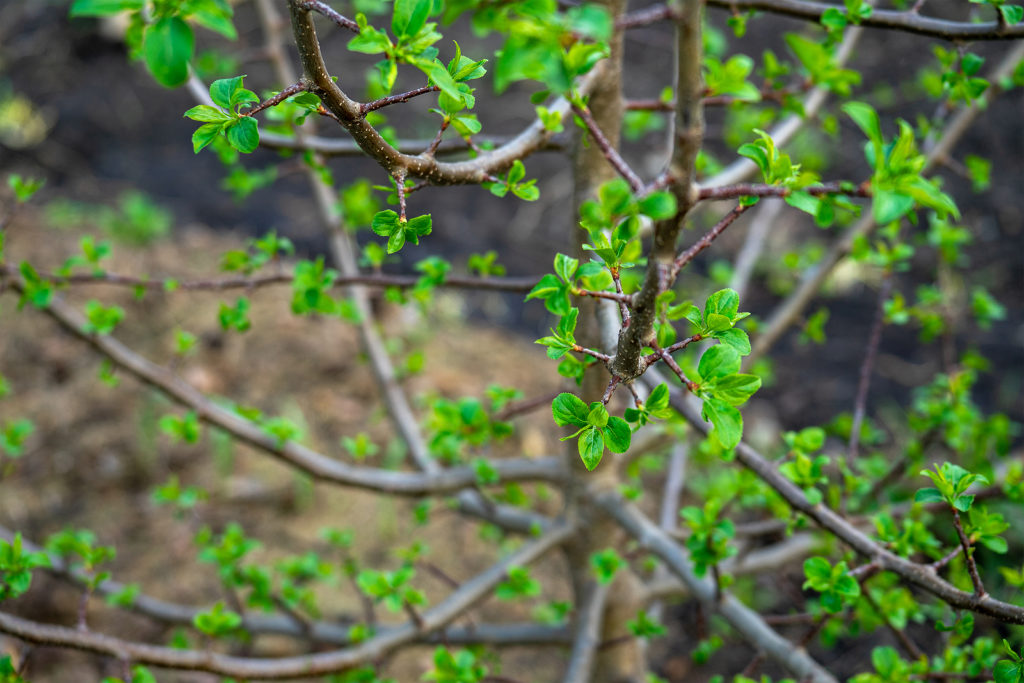
Plum
- Late winter: Treat trees with dormant spray to protect against aphids and other insects. Prune out any branches that show signs of black knot.
- Early spring: Begin planting bare-root trees as weather and soil conditions allow. Prune trees for training purposes.
- Mid-spring: Blossoms appear on mid-season and late-flowering varieties. Protect blossoms against frost. Pinch out unwanted new buds and shoots on wire-trained trees. If black knot was a problem last year, apply two sprays of lime-sulfur as a preventative, one week apart.
- Late spring: Fruitlets form and begin to swell. Weed and water regularly. Shake trees to knock loose plum curculios on a dropcloth then destroy them. Repeat daily.
- Early summer: Support heavily laden plum and damson branches to prevent breaking and splitting. Breaks that result in large wounds are susceptible to infections such as silver leaf fungus. (Silver leaf fungus also attacks cherries, peaches, nectarines, apples, and pears.) Keep the centers of bush trees open. Remove dead, broken, and diseased limbs. Remove crossing and rubbing branches. Shorten the leaders on dwarf and semi-dwarf trees that lack vigor; prune laterals to about 6 inches. Prune fan-trained and espaliered trees by cutting back by half laterals that have already been pinched to six or seven leaves. Remove dead and diseased wood. Tie new shoots into the support frame to fill available space or replace worn-out shoots. Spray against mealy plum aphids or other pests as necessary. Hang pheromone traps to prevent peach tree borer and oriental fruit moth damage.
- Mid-summer: Support heavily laden trees until harvest. Harvest early- and late-season fruit as soon as the fruit ripens; a ripe plum will be fully colored and slightly soft. Plums on the same tree will not ripen at the same time; harvest each tree more than once. Harvest with a short length of stalk attached to the fruit. Eat ripe plums right away; under-ripe plums will keep a couple of weeks at near-freezing temperatures.
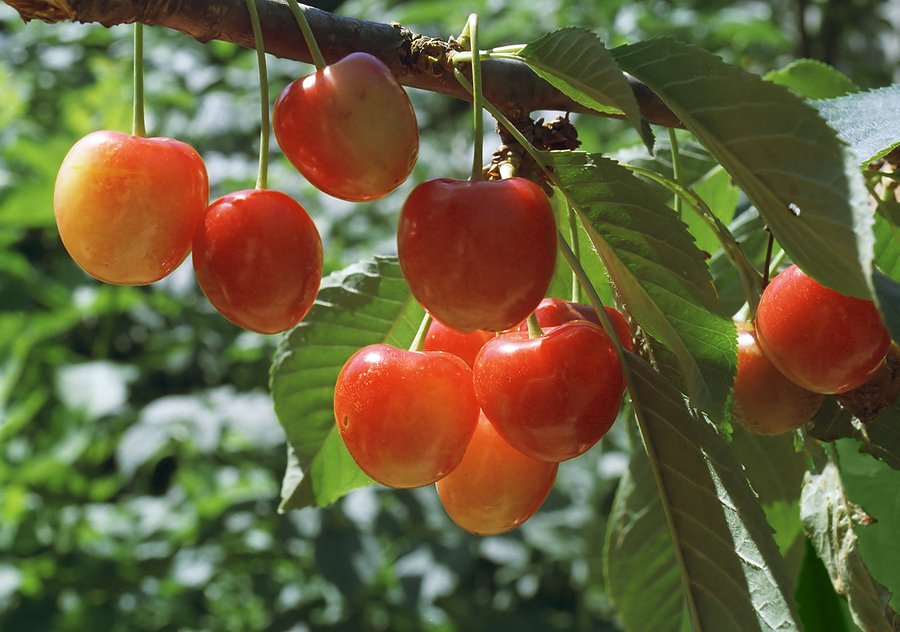
Cherry
- Late winter: Treat trees with dormant oil spray to protect against aphids, winter moths, and other pests. Prune out any branches that show signs of black knot.
- Early spring: Begin planting bare-root trees as conditions allow.
- Mid-spring: Most cherries flower now. Protect blossoms against frost. If black knot was a problem last year, apply two sprays of lime-sulfur as a preventive, one week apart.
- Late spring: Keep newly planted trees watered. Shake trees to knock loose plum curculios onto a dropcloth; destroy the pests. Repeat daily.
- Early summer: Harvest early-season cherries now. Cover trees with nets to protect against birds Hang pheromone traps to prevent peach tree borer and oriental fruit moth damage. Rub out unwanted buds on standard trees to produce a good shape.
- Mid-summer: Cherries should be picked from the tree fully ripe. If the skins are splitting while the fruit is still on the tree, pick and eat them right away. Use scissors or pruners to harvest cherries leaving the stems on the fruits. Avoid damaging the fruiting spurs which will bear next year’s fruit. If rain or humid weather is forecast, harvest as soon as the fruit is ripe, otherwise it will absorb moisture, and skins will crack. Eat or cook cherries soon after harvest. Washed and dried, cherries will keep in the refrigerator for a few days. Remove and destroy any fruit infected with brown rot. Feed trees after the end of harvest. Spray sour cherries with a copper to control bacterial canker.
- See also, Sweet Cherry Varieties and Sour Cherry Varieties.
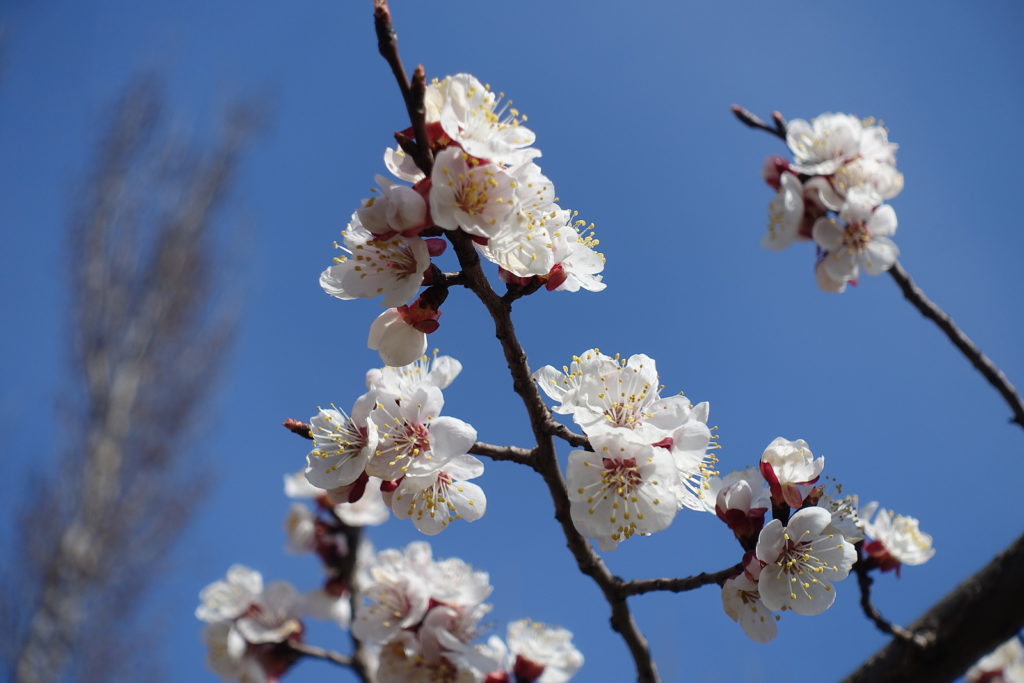
Apricot
- Early spring: Buds will start to open in a warm spring. Protect blossoms from frost. Hand-pollinate flowers if necessary. Weed and mulch around trees. Prune newly planted trees.
- Mid-spring: Prune established trees in late spring. As fruitlets form, begin thinning them out. Fertilize established trees. If black knot was a problem last year, apply two sprays of lime-sulfur as a preventive, one week apart.
- Late spring: Weed and water regularly. Shake trees to knock loose plum curculios onto a dropcloth; destroy the pests. Repeat daily.
- Early summer: Thin out young apricot fruitlets. Leave 3 to 4 inches (8-10 cm) between each fruit. Remove diseased and damaged fruit first. As fruit ripens net trees or individual fruit clusters to protect against bird damage. Water trees regularly and feed lightly with a general blended fertilizer.
- Mid-summer: Apricots come to harvest mid-to-late-summer. Test for near ripeness by holding a fruit in your hand and giving it a gentle twist leaving the stalk behind. Apricots will keep for a day or two in a cool place. Apricots will not ripen further after harvest. Freeze or dry surplus fruit. Feed trees after the end of harvest; spread two inches of compost out to the drip line.
- See also Apricot Varieties.
Peach and Nectarine
- Early spring: Blossoms open. Protect blossoms from frost and hand-pollinate if necessary. Weed and mulch around trees. Prune newly planted trees by mid-spring. Apply an all-purpose fertilizer around trees. Plant bare-root trees.
- Mid-spring: As fruitlets form and begin to swell, begin thinning them out. In hot climates, feed trees with a liquid fertilizer while fruits are developing. If black knot was a problem last year, apply two sprays of lime-sulfur as a preventive, one week apart.
- Late spring: Weed and water regularly. Shake trees to knock loose plum curculios onto a dropcloth; destroy the pests. Repeat daily.
- Early summer: Thin out fruit as necessary. Thin to one fruit per cluster. Peaches should be 8 to 10 inches (20-25 cm) apart; thin nectarines to 6 inches (15 cm) apart. Protect fruit against birds, earwigs, and wasps by placing muslin or paper bags on individual fruits. Tie in new growth on espaliered trees.
- Mid-summer: Peaches and nectarines are ready to be picked when they become slightly soft at the top. Give the fruit a gentle twist; ripe fruit will come away easily. Ripening does not continue after harvest. Peaches and nectarines will store for two to four weeks at very cool temperatures. Feed trees after the end of harvest. Clean away old mulch after harvest.
- See also Peach Varieties and Nectarine Varieties.

Fig
- Early spring: Plant trees before they emerge from winter dormancy. Weed and mulch around trees. Apply an all-purpose fertilizer.
- Mid-spring: The first fruitlets start to form; in hot climates, they should ripen by late summer; in cool climates, they are unlikely to ripen. Spring-prune established trees, cutting back unwanted growth and encouraging new fruiting shoots.
- Late spring: Remove insulation used to protect trees during winter. Begin regular watering. Give trees liquid fertilizer while fruits are developing between now and late summer.
- Early summer: Summer prune established fig trees. Pinch out new shoots to encourage the growth of new fruitless.
- Mid-summer: Figs are ready for harvest when they are fully colored and turn slightly soft; the fruit will bend slightly downward on the stem. Don’t harvest figs too soon; they will not ripen much off the tree. Ripe figs are soft and the skin may be starting to split. After harvest new fruits will begin to appear; these will overwinter as tiny embryo fruit. These fruits will be ready for harvest next summer. In warm climates, there is a fig harvest in early summer and again in late summer; in cooler regions, there is one fig harvest, from late summer to fall.
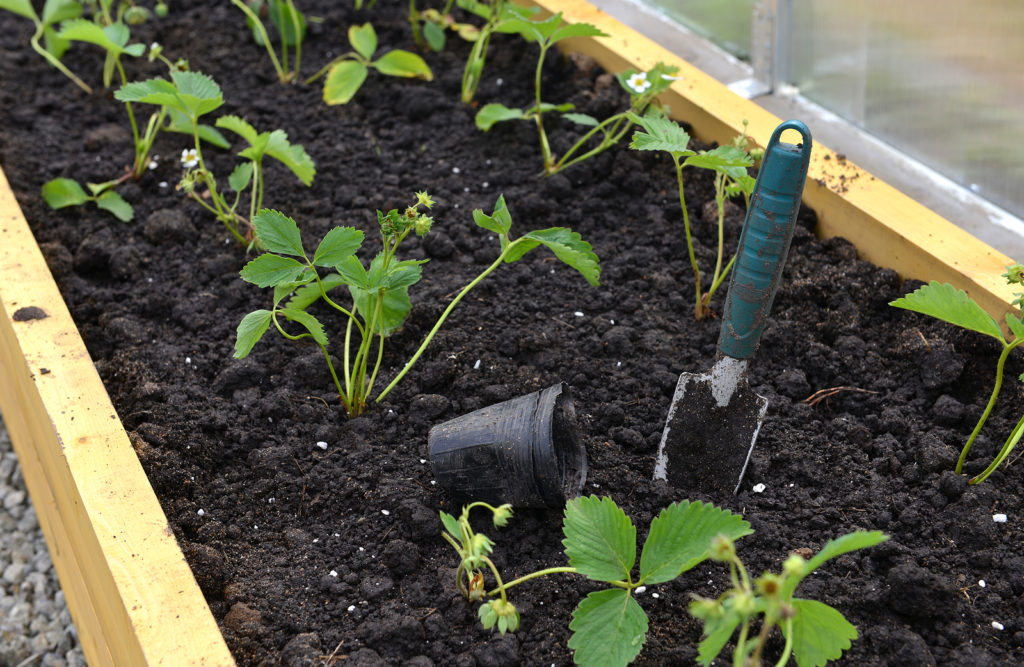
Bushes, Brambles, and Soft Fruit Crop-by-Crop Tips
Strawberry
- Early spring: Cover outdoor plants with cloches or tunnels in order to force an early crop. Feed plants with an organic all-purpose fertilizer. Plant bare root runners or pot-grown strawberries outdoors now until mid-spring. Plant day-neutral varieties outdoors now until mid-spring; they should fruit late in summer.
- Mid-spring: Most varieties flower now or in late spring. Protect plants against frost but uncover plants to allow pollination. As the fruit begins to appear, spread a layer of straw around and underneath plants if they are not on mats.
- Late spring: Water regularly as berries fatten up and ripen. Protect plants against slugs, and net plants to keep birds away. Harvest early-season summer-fruiting varieties.
- Early summer: Harvest early- and mid-season summer fruiting varieties. Keep beds clean. Trim away old leaves. Remove runners, unless you want to establish new plants. Older plants that have produced three or more crops and begun to lose vigor can be removed to make way for new plants. Certain varieties can be encouraged to produce a fall crop by removing all of the plant’s leaves; new leaves will be produced in 10 to 14 days. Apply a complete fertilizer at the rate of 2 ounces per square yard. Control weeds by shallow cultivation.
- Mid-summer: Trim back strawberry plants that have just finished fruiting. Plant rooted-runner of day-neutral varieties between now and mid-fall; these will fruit next summer. Root runners in pots so that you can protect them from freezing this winter.
- See also Strawberry Varieties for Home Gardens and Starting Strawberries from Runners.
Raspberry
- Late winter: Tip-prune overwintering summer-bearing canes. Cut down and remove all of last year’s fall-bearing canes if not done.
- Early to mid-spring: New leaves start to appear on last year’s summer-bearing canes. New canes start to shoot from below ground on fall-bearing varieties. Feed plants with an all-purpose organic fertilizer. Plant new bare-root canes now.
- Late spring: Flower buds form and blossoms open for pollination. Weed and water. Net summer-bearing berries against birds.
- Early summer: Pick the raspberry fruit as it ripens. Water plants once a week especially if the weather is dry. After harvest, cut off old canes close to the ground leaving room for new growth to bear next year’s crop. New shoots can be tied off as they reach support wires or frames. Cut away weak new shoots to avoid crowding. Remove suckers (shoots rising from roots below ground) that are too far from the row itself. Control weeds.
- Mid-summer: Protect still developing raspberries against birds with netting; destroy nearby wasp nests before they begin visiting ripening fruit. Cut down and remove summer-bearing canes that have finished fruiting. These canes will die soon, so clean them out of the berry patch before disease or insects appear. Tie in new canes for next year.
- See also How and When to Prune Raspberries and Raspberry Varieties.
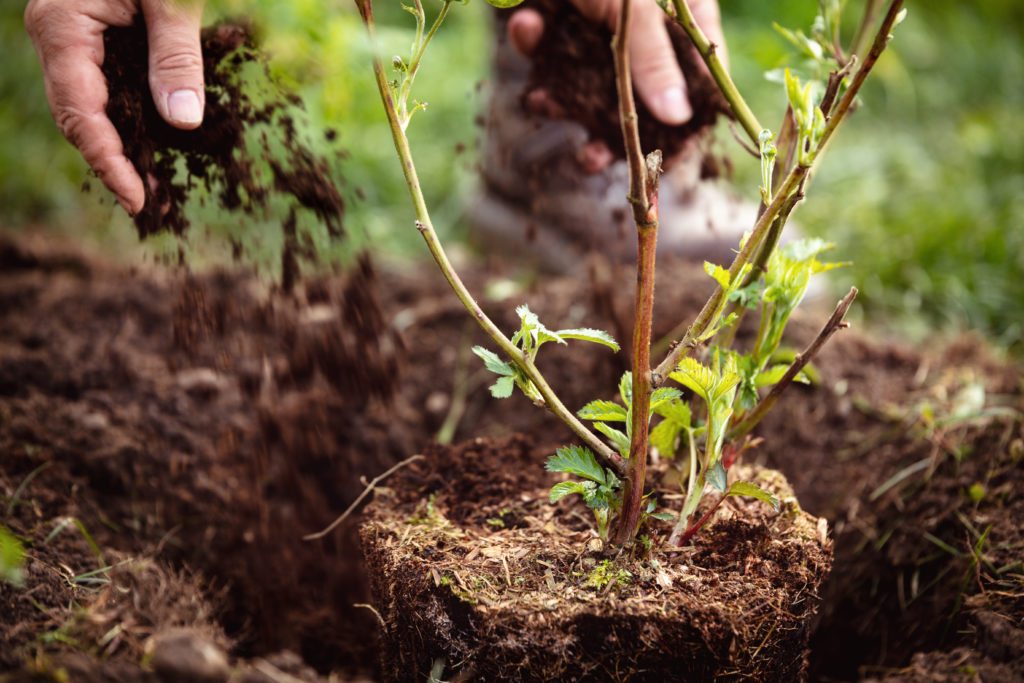
Blackberry
- Late winter: Spread out and tie in last year’s new canes.
- Early to mid-spring: Leaf buds begin to open and new leaves appear. Feed with an all-purpose fertilizer. Weed and mulch around plants. Plant new bare-root canes. Uproot new plants propagated by tip layering and transplant.
- Late spring: Blossoms should be open; pollinating insects will visit. First fruitlets start to form as the blossoms drop. Weed and water as needed.
- Early summer: In dry regions, water generously at least once a week, especially when berries are turning color. Hybrids may need nets to keep birds away, more so than blackberries. Train in new shoots. Keep new shoots separate from fruiting shoots to avoid the spread of disease. Control weeds.
- Mid-summer: Mid-season blackberries are ready for harvest when they are plump and shiny black. They should pull away from the vine easily. Loganberries should be picked when they are ripe and dark crimson. Unripe fruits will not ripen after picking. After harvest, cut out shoots that have fruited. Leave new growth to replace the trimmed-away shoots. Bramble berries will keep no much longer than three days at temperatures just above freezing.
Gooseberry
- Late winter: Winter-prune established gooseberries.
- Early spring: Plant bare-root gooseberries as soon as the ground is workable. Apply potassium sulfate and an all-purpose fertilizer around plants. Buds begin to burst and new leaves appear. Prune newly established gooseberries.
- Mid-spring: Blossoms open. Protect plants against frost. Mulch around plants to suppress weeds. Spray against insects after blossoms drop.
- Late spring: Fruitlets form and begin to swell. Start thinning unripe fruits by picking every other berry. Weed and water as needed. Inspect the center of bushes for larvae of imported currant worm; pick them off and destroy them.
- Early summer: Fruitlets are swelling now. Pick ripening fruit quickly to allow other berries to ripen. Watch for sawfly attacks. Control weeds. Look for larvae of imported currant worms; pick off and destroy them.
- Mid-summer: Protect berries from birds with bird netting as fruits begin to ripen. Harvest from mid-to-late summer. Eat gooseberries soon after harvest for the best flavor. Gooseberries will keep in the refrigerator for about 10 days. Black currants will keep for one a day or two in a sealed container in the refrigerator. Control leaf spot by applying a copper fungicide after fruit picking.
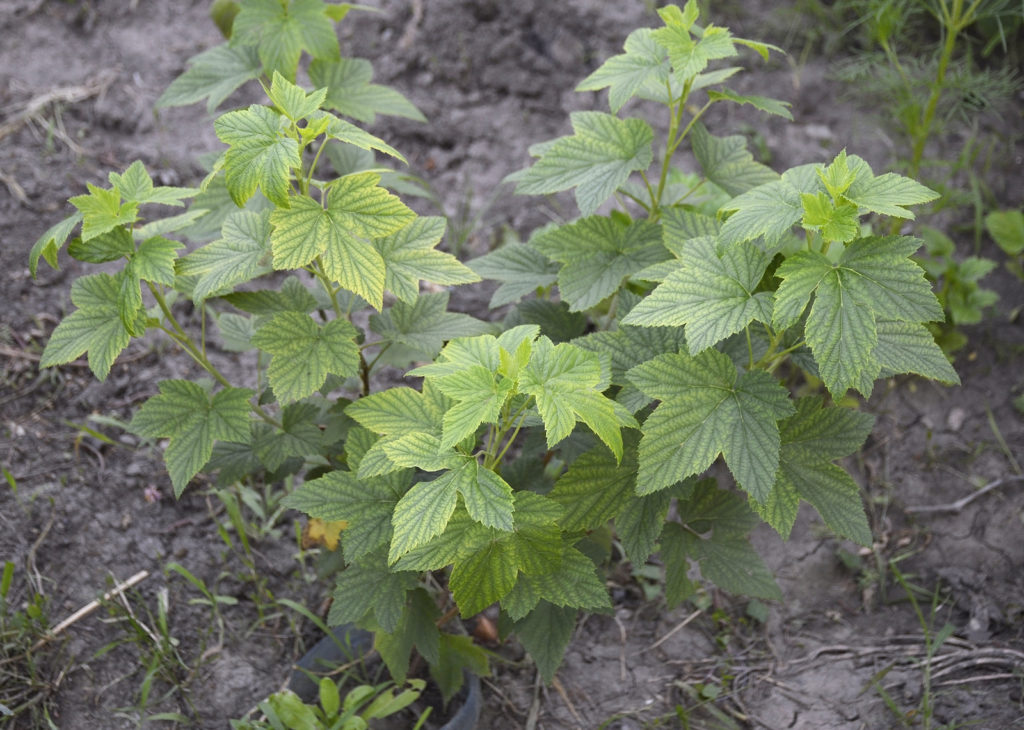
Red Currant
- Late winter: Winter-prune newly planted and established currants. New buds should be swelling.
- Early spring: Plant bare-root currants as soon as the ground can be worked. Apply potassium sulfate and an all-purpose fertilizer. New young leaves and flowers will appear. Protect blossoms against frost. Mulch around plants to suppress weeds.
- Mid-spring: Blossoms are fully open and pollinating insects should be around. Spray against plant bugs after blossoms have fallen.
- Late spring: Fruitlets form and begin to swell. Weed and water regularly.
- Mid-summer: Protect berries from birds with bird netting as fruits begin to ripen. Harvest from mid-to late-summer. Currants do not ripen all at once; so revisit the plant more than once. Currants will keep in the refrigerator for about 10 days. Black currants will keep for one a day or two in a sealed container in the refrigerator. Control leaf spot by applying a copper fungicide after fruit picking.
Black Currant
- Late winter: Winter-prune newly planted and established currants.
- Early spring: Plant bare-root currants as soon as the ground can be worked. Apply ammonium sulfate and an all-purpose fertilizer. New young leaves and flowers will appear. Protect blossoms against frost. Mulch around plants to suppress weeds.
- Mid-spring: Blossoms are fully open and pollinating insects should be around. Spray against plant bugs after blossoms have fallen.
- Late spring: Fruitlets form and begin to swell. Weed and water regularly.
- Early summer: Pick fruit as soon as it ripens. Fruit does not hang long on the bush once ripe. Next year’s fruit-bearing shoots will be breaking ground and making growth now. Allow new shoots to make substantial growth before deciding which to remove. Keep weeds under control by careful cultivation. Water regularly.
- Mid-summer: Protect berries from birds with bird netting as fruits begin to ripen. Harvest from mid-to late-summer. Currants do not ripen all at once; so revisit the plant more than once. Currants will keep in the refrigerator for about 10 days. Black currants will keep for one a day or two in a sealed container in the refrigerator. Control leaf spot by applying a copper fungicide after fruit picking.
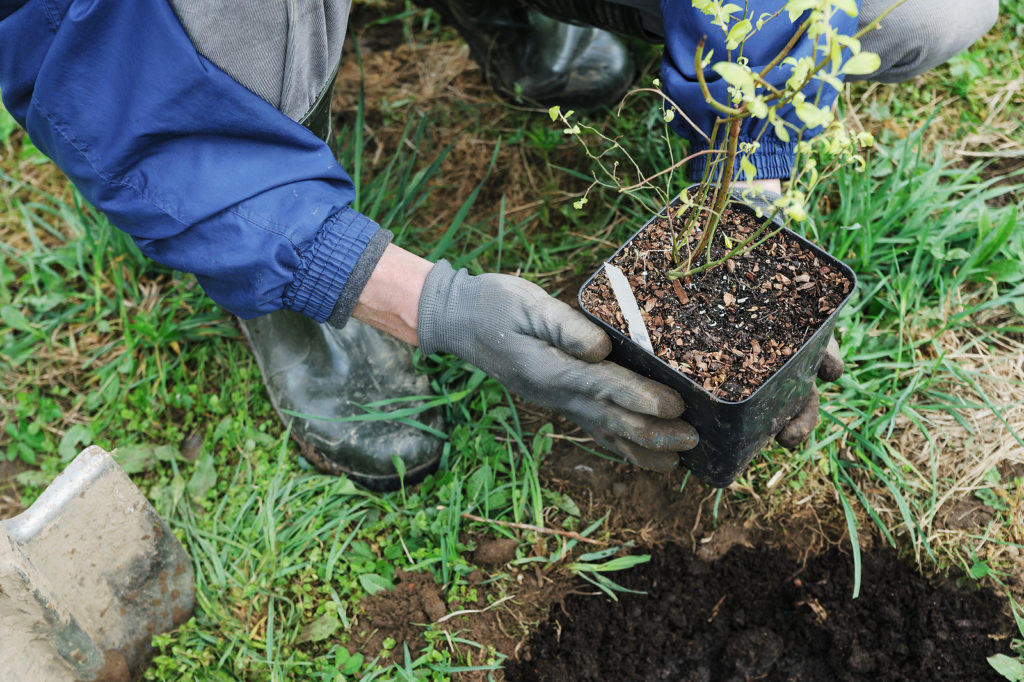
Blueberry
- Late winter: Prune blueberry bushes now through early spring. Apply dormant oil to control aphids or scales.
- Early spring: Young leaves and blossoms start to appear on early-flowering varieties. Protect plants against frost if necessary. Spread acidic mulch around plants.
- Mid-spring: Blossoms are fully open on most bushes and pollinating insects are around. Pot on blueberries in containers. Plant new bushes; remove flowers so plant direct nutrients into establishing a root system. Feed plants with a lime-free general fertilizer.
- Late spring: Late-flowering varieties are in flower. As blossoms drop, small fruitlets form and swell. Weed and water regularly. Continue to remove blossoms from new bushes. If blueberry maggots were a problem in the past, cover bushes with floating row covers once fruit has set.
- Early summer: Harvest early- and mid-season fruit now. Place nets over plants to protect against birds.
- Mid-summer: Harvest mid and late-season fruits a few days after they have turned blue when they have reached full sweetness and aroma. Early varieties are finished harvest now. Blueberries on the same bush do not ripen all at the same time; go over each bush several times. Ripe blueberries can be gently coaxed with your fingertips from the clusters; leave unripe berries for the next round of picking in a day or two. Blueberries will keep for a week or more in the refrigerator.
- See also Blueberry Types and Varieties and Easy to Grow Blueberries.
Grape
- Late winter: Winter-prune established cordons now into early spring. Apply an all-purpose fertilizer around the vines.
- Early spring: Plant bare-root vines before they come out of dormancy. Re-tie cordons that have been allowed to hang horizontally. Weed and mulch around vines.
- Mid-spring: Plant young container-grown vines now until late spring. Prune established cordons thinning to two shoots on each spur.
- Late spring: Flowers are usually open now. Begin weeding and watering regularly. Give vines a regular liquid feed while grapes are developing, and continue feeding until late summer.
- Mid-summer: Place nets over vines to keep birds away from ripening fruit. Prune out excessive foliage to let sun and air reach ripening grapes. Leave the fruit on the grapevine until it is ripe–fully colored and full-flavored.
- See also Growing Backyard Grapes and Grape Types and Varieties.
Citrus
- Mid-summer: In warm regions, citrus may still be flowering; fruit set has started for many trees. From flower to harvest, most citrus takes about six months to come to harvest, grapefruit about 18 months. Most citrus is self-fertile. Regular water is essential in summer to avoid flower or fruit drop; citrus in pots should be thoroughly soaked. Feed citrus three times between spring and fall; use citrus or all-purpose fertilizer.
Related articles:
Planning the Home Fruit Garden
Garden Planning Books at Amazon:
- Vegetable Garden Almanac & Planner
- Kitchen Garden Grower’s Guide Vegetable Encyclopedia
- Vegetable Garden Grower’s Guide
- Tomato Grower’s Answer Book



